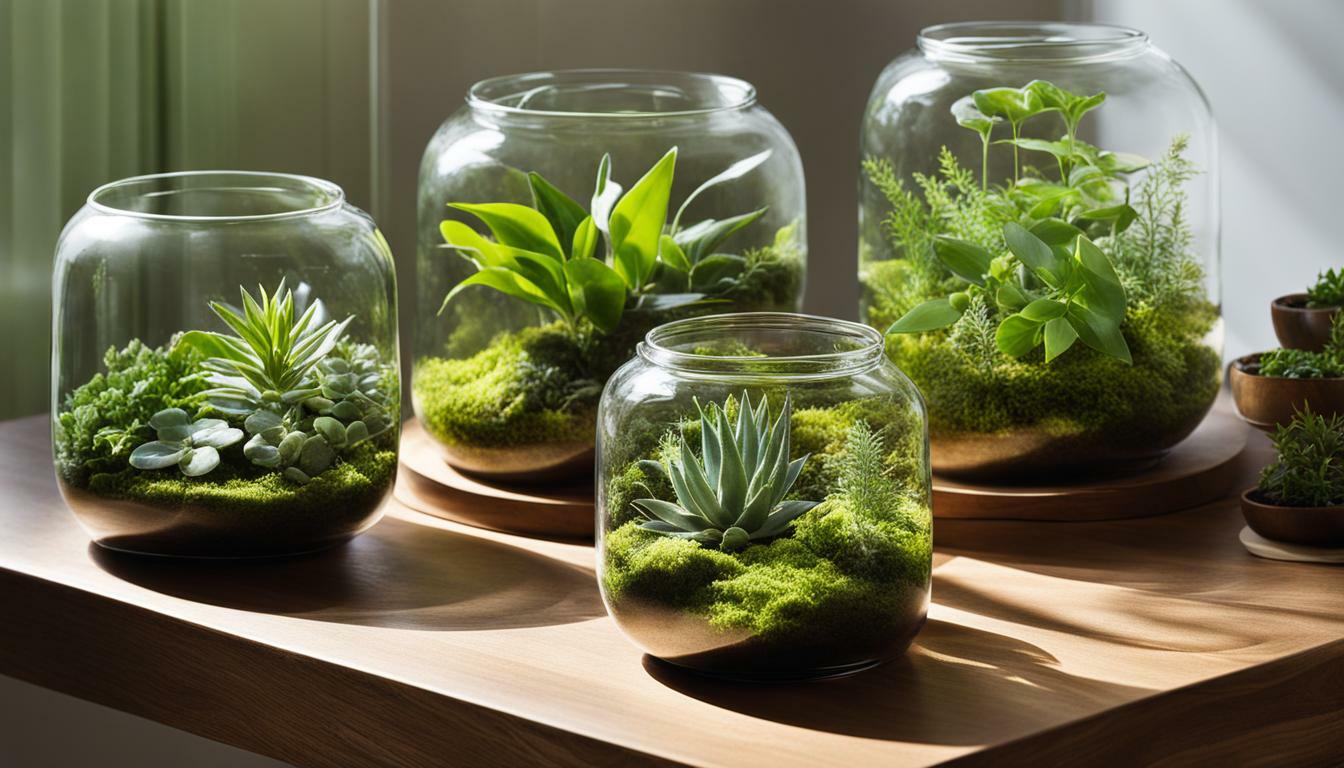Glass container terrariums are a stunning addition to any interior or decor, bringing the beauty of nature indoors. These miniature ecosystems have been popular for about a hundred years and provide a unique way to showcase plants while creating a captivating focal point.
Key Takeaways:
- Terrariums have been around for about a hundred years and are a popular way to bring nature indoors.
- Choose clear glass containers over plastic for optimal transparency and aesthetic appeal.
- Closed terrariums require less maintenance and provide a self-sustaining environment.
- Essential materials for terrarium building include clear glass or plastic containers, pea gravel for drainage, horticultural charcoal to prevent odor, and potting soil.
- Select plants with similar light and temperature requirements to create a harmonious environment.
The History and Popularity of Terrariums
Terrariums have been around for about a hundred years and have gained immense popularity as a way to incorporate nature into our living spaces. These miniature ecosystems allow us to bring the beauty of the outdoors inside our homes, providing a sense of tranquility and a connection with nature.
The concept of terrariums dates back to the mid-1800s when a British physician named Nathaniel Ward accidentally discovered that plants enclosed in a sealed glass container could thrive on their own. His discovery revolutionized the way people could enjoy plants, especially in urban environments where outdoor space is limited.
Since then, terrariums have become a beloved hobby for plant enthusiasts and a trendy interior decor element. Their popularity surged in the mid-20th century, and they continue to be a staple in homes, offices, and even public spaces today. There is something captivating about observing a tiny self-sustaining ecosystem that adds a touch of serenity and natural beauty to any environment.
Whether you prefer an open or closed terrarium, the possibilities are endless when it comes to choosing plants, designing the layout, and adding decorative elements. The versatility of terrariums makes them suitable for all kinds of spaces, from small apartments to large offices.
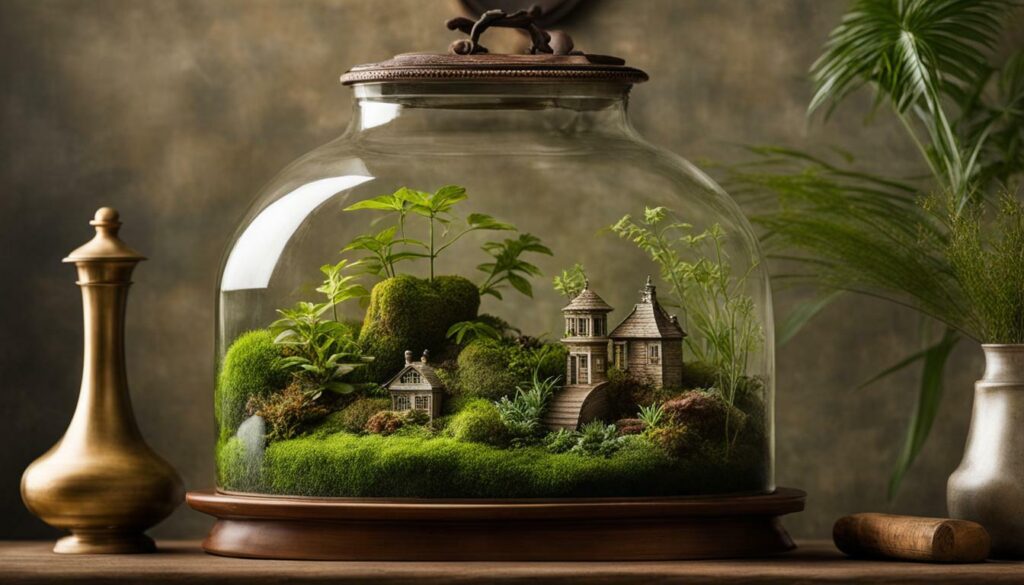
- Low maintenance: Terrariums require minimal care and attention, making them ideal for busy individuals or those without a green thumb.
- Purify the air: The plants enclosed in a terrarium naturally filter the air, improving its quality and creating a healthier indoor environment.
- Year-round greenery: With the right plant selection, terrariums can provide a constant source of greenery, even during the colder months when outdoor gardens are dormant.
- A sense of tranquility: The sight of lush greenery and the calming effect of nature can create a peaceful and serene atmosphere, reducing stress and improving overall well-being.
Whether you are a seasoned plant enthusiast or just starting your indoor gardening journey, terrariums offer a unique opportunity to create a captivating miniature world. The combination of natural elements and artistic design allows you to express your creativity and showcase your personal style while enjoying the beauty of nature.
| Type | Advantages |
|---|---|
| Open terrarium | Allows for better airflow and is suitable for plants that prefer slightly drier conditions. |
| Closed terrarium | Creates a humid environment, making it ideal for plants that thrive in moisture and require less frequent watering. |
Types of Terrariums: Closed or Open
When it comes to terrariums, there are two main types: closed terrariums and open terrariums. Each type has its own unique characteristics and maintenance requirements. Closed terrariums, as the name suggests, are enclosed with a lid or cover, creating a miniature greenhouse effect. This closed environment helps to retain moisture and create a self-sustaining ecosystem. Open terrariums, on the other hand, do not have a lid and allow for more airflow. This type of terrarium is ideal for plants that prefer drier conditions, as the excess moisture can easily evaporate.
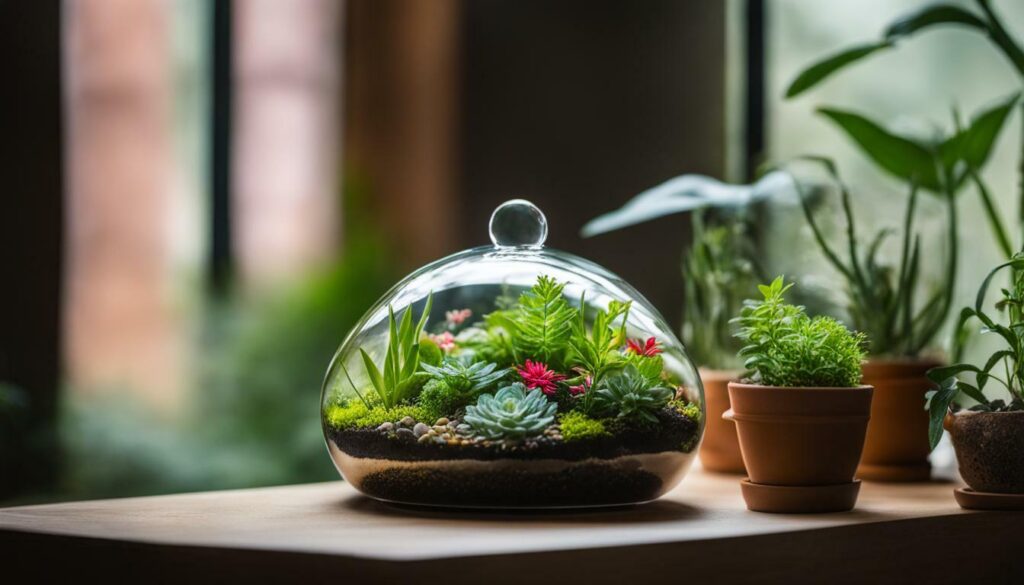
Building a closed terrarium requires careful attention to the moisture levels within the container. The lid should only be opened occasionally to allow for air circulation and prevent excessive humidity. On the other hand, open terrariums require regular monitoring as they are more susceptible to drying out. It’s important to strike a balance between watering and allowing the soil to dry out slightly between waterings.
Pros and Cons of Closed and Open Terrariums
| Closed Terrariums | Open Terrariums | |
|---|---|---|
| Moisture Retention | High | Low |
| Air Circulation | Low | High |
| Maintenance | Low | High |
| Plant Choices | Moisture-loving plants | Drought-tolerant plants |
When deciding between a closed or open terrarium, consider the specific needs of the plants you wish to include. Closed terrariums are perfect for creating a lush, humid environment that is suitable for ferns, moss, and other moisture-loving plants. Open terrariums, on the other hand, are better suited for succulents, cacti, and other plants that thrive in drier conditions. Whether you choose a closed or open terrarium, both can be a beautiful and low-maintenance way to bring a touch of nature into your home.
Building Your Own Glass Container Terrarium
Creating your own glass container terrarium is a rewarding and creative DIY project that allows you to customize your miniature indoor garden. Whether you have a green thumb or are just starting out with gardening, a terrarium is a low-maintenance and stylish way to bring nature into your home. By following a few simple steps, you can create a beautiful glass container terrarium that will be a unique addition to your space.To start, gather the essential materials needed for your terrarium. You will need a clear glass or plastic container with a cover, such as a jar or vase. Glass containers are generally recommended over plastic as they provide better visibility and aesthetic appeal. Additionally, they allow plants to receive the necessary light for photosynthesis. Next, gather pea gravel for drainage, horticultural charcoal to prevent a sour odor, and potting soil. These materials will create a suitable environment for your plants to thrive.When it comes to selecting plants for your terrarium, choose ones that have similar light and temperature requirements. This will ensure that they can coexist harmoniously within the enclosed space. It is also advisable to place taller plants at the back of the terrarium to create depth and visual interest. Once you have chosen your plants, carefully plant them in the terrarium, making sure to leave enough room for growth. After planting, spray the sides of the container and the leaves of the plants to remove any dirt and provide moisture.Maintaining your terrarium is relatively simple. Place it in an area with plenty of natural light, but avoid direct sunlight as this can cause excessive heat and damage to the plants. Every couple of weeks, give your terrarium a gentle spray of water to ensure that the soil remains moist but not waterlogged. This will help create a humid environment that mimics the natural conditions required for the plants to thrive.In summary, building your own glass container terrarium is an enjoyable and fulfilling DIY project. It allows you to exercise your creativity while creating a beautiful miniature indoor garden. By carefully selecting the right materials, plants, and maintenance practices, you can create a thriving and visually appealing terrarium that will bring a touch of nature into your home.| Materials |
|---|
| Clear glass or plastic container |
| Pea gravel |
| Horticultural charcoal |
| Potting soil |
| Plants with similar light and temperature requirements |
Essential Materials for Terrarium Building
To build a glass container terrarium, you will need a clear glass or plastic container, pea gravel for drainage, horticultural charcoal to prevent odors, and potting soil. These materials are essential for creating a healthy and thriving terrarium ecosystem.
The clear glass or plastic container acts as the home for your terrarium, allowing you to observe the beauty of the enclosed plants and creating a visually appealing centerpiece. It’s important to choose a container that is large enough to accommodate your plants and has a lid if you opt for a closed terrarium.
Pea gravel is used as a drainage layer at the bottom of the container. This layer helps to prevent water from pooling at the roots of the plants, ensuring proper moisture control. It also helps to create a barrier between the soil and the water, preventing root rot and waterlogged conditions.
Horticultural charcoal is an important component of a terrarium as it helps to filter out toxins and prevents any sour odors. It acts as a natural purifier, keeping the terrarium environment clean and fresh. Potting soil provides the necessary nutrients for plant growth and serves as the medium for the plants to flourish.
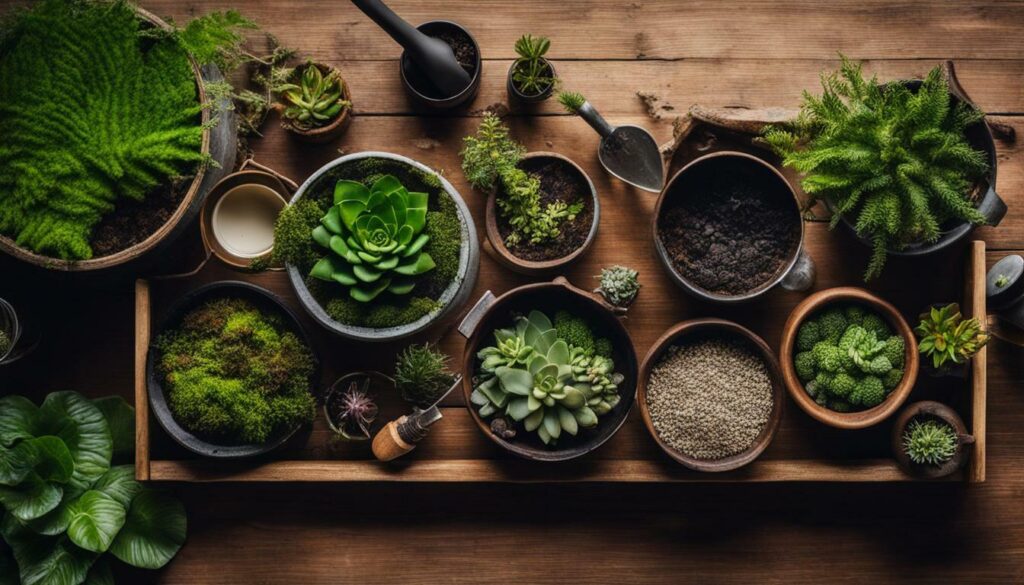
Creating a terrarium is a rewarding DIY project that allows you to bring a piece of nature indoors. By gathering these essential materials and following the proper steps, you can build a beautiful glass container terrarium that will become a stunning addition to your home or office space.
| Materials | Description |
|---|---|
| Clear glass or plastic container | Provides a transparent view of the terrarium and serves as the home for the plants |
| Pea gravel | Acts as a drainage layer to prevent waterlogging and root rot |
| Horticultural charcoal | Filters out toxins and prevents odors, keeping the terrarium environment fresh |
| Potting soil | Provides necessary nutrients for plant growth and serves as the medium for the plants |
Choosing the Right Plants for Your Terrarium
When choosing plants for your terrarium, it’s important to consider their light and temperature requirements, as well as the height of the plants. Similar light and temperature requirements are crucial to ensuring that all plants in your terrarium thrive together. This will help create a harmonious and visually appealing mini-ecosystem.
For taller plants, it’s best to position them towards the back of the terrarium to create depth and dimension. This will prevent them from overshadowing smaller plants and allow each plant to receive adequate light.
Here are some popular plant options for your glass container terrarium:
- Ferns: These beautiful foliage plants thrive in high humidity environments, making them an excellent choice for closed terrariums.
- Succulents: Succulents are low-maintenance and come in a variety of shapes and colors. They are well-suited for open terrariums that receive plenty of indirect sunlight.
- Moss: Moss adds a lush and carpet-like appearance to your terrarium. It is perfect for shaded areas and requires minimal watering.
- Air plants: These unique plants don’t require soil and can be attached to rocks or other decorative elements. They do well in open terrariums with good air circulation.
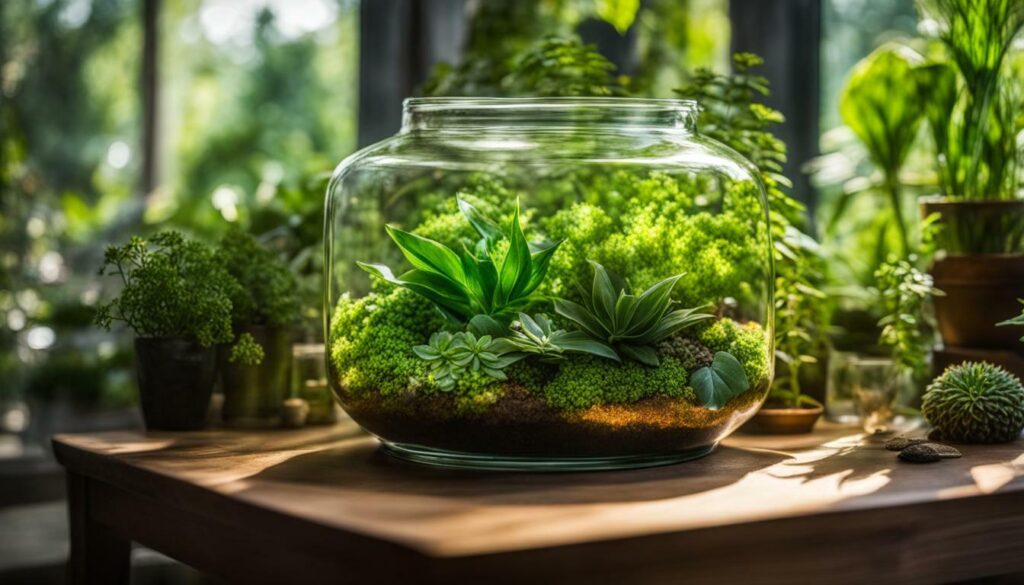
Remember to research each plant’s specific care requirements and ensure they are compatible with your terrarium’s conditions. By carefully selecting your plants, you can create a captivating glass container terrarium that brings a touch of nature and beauty to any indoor space.
Planting and Maintenance Tips
After planting your terrarium, it is essential to spray the sides of the container and the leaves of the plants to remove any dirt and dust. This not only helps keep your terrarium clean and visually appealing but also ensures that the plants can photosynthesize properly. Using a spray bottle filled with water, gently mist the interior of the glass container, making sure to reach all areas. Be careful not to oversaturate the soil to avoid creating a waterlogged environment.
In addition to regular spraying, it’s important to monitor the moisture levels in your terrarium. Most terrarium plants prefer slightly moist but not soggy soil. A good way to check if your terrarium needs watering is to press your finger about an inch into the soil. If it feels dry, it’s time to water. Use a watering can with a narrow spout or a small funnel to direct the water directly onto the soil without disturbing the plants.
Keep in mind that different plants have different watering needs. Some plants, such as succulents, prefer drier conditions, while others, like ferns, thrive in more humid environments. Research the specific requirements of the plants in your terrarium to ensure you provide them with the appropriate level of moisture.
Preventing Mold and Fungus
Proper ventilation is crucial for preventing mold and fungus growth in your terrarium. While closed terrariums create a more humid environment suitable for certain plants, they also trap moisture, which can lead to the development of mold. To maintain a healthy terrarium, consider opening the lid periodically to allow fresh air to circulate. If you notice any signs of mold or fungus, remove the affected plants and clean the container thoroughly before replanting.
| Planting and Maintenance Tips: |
|---|
| 1. Spray the sides of the container and leaves of the plants to remove dirt and dust. |
| 2. Monitor moisture levels and water when the soil feels dry. |
| 3. Different plants have different watering needs, so research their specific requirements. |
| 4. Prevent mold and fungus by providing proper ventilation and opening the lid periodically. |
Maintaining a glass container terrarium requires regular care, but the effort is well worth it. With the right watering routine and attention to cleanliness, you can enjoy a thriving miniature garden that brings nature’s beauty into your home.
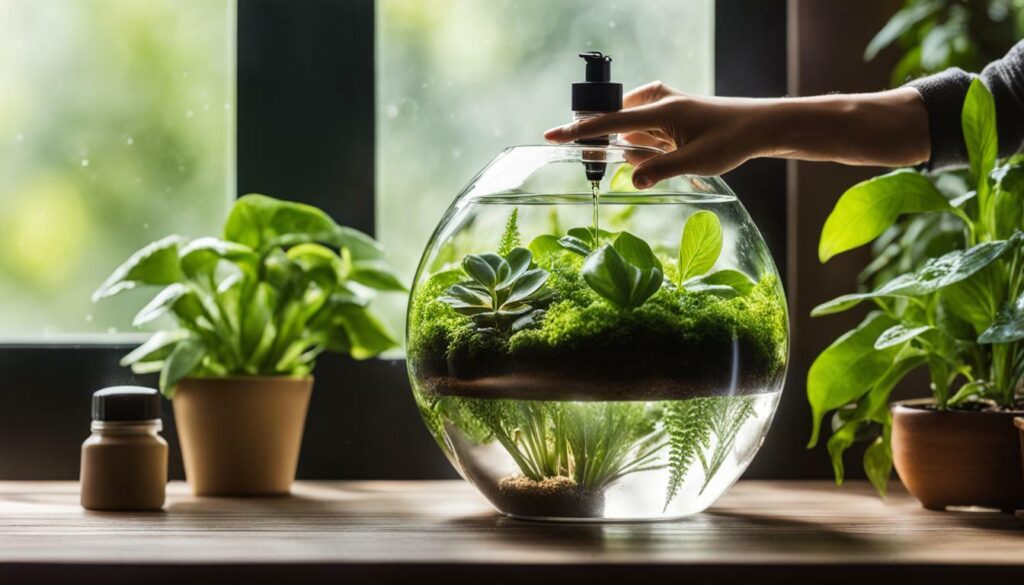
Glass containers are highly recommended for terrariums due to their transparency, allowing plants to receive the necessary light for photosynthesis. The clear glass allows sunlight to penetrate the terrarium, providing the plants with the energy they need to grow and thrive. This is especially important in closed terrariums, where the container is fully enclosed and the plants rely solely on the available light.
Unlike plastic containers, glass containers do not block or filter out any light, ensuring that the plants receive the full spectrum of natural sunlight. This is essential for photosynthesis, the process by which plants convert light energy into food. With glass containers, you can create a miniature ecosystem that mimics the natural conditions necessary for plants to flourish.
Another advantage of glass containers is their aesthetic appeal. The transparency of the glass allows you to fully appreciate the beauty of your terrarium, showcasing the intricate details of the plants and the overall composition. Whether you choose an open or closed terrarium, the glass container adds a touch of elegance and sophistication to any room or space.
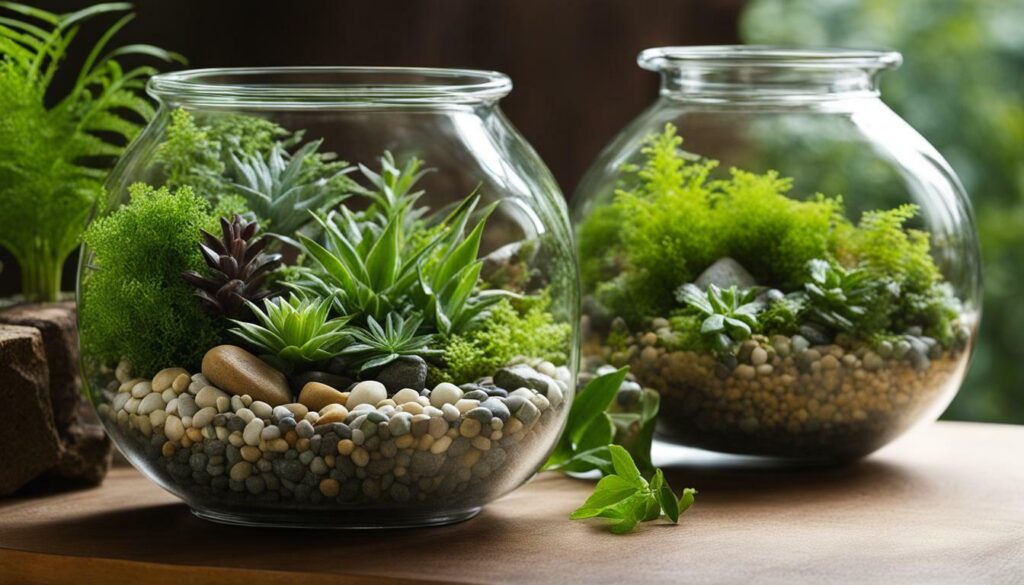
When selecting a glass container for your terrarium, opt for one with a wide opening that provides easy access for planting and maintenance. Additionally, ensure that the container has a secure lid or cover to create a sealed environment for closed terrariums. This will help retain moisture and create the ideal conditions for your plants to thrive.
In summary, glass containers offer numerous advantages for terrarium enthusiasts. With their transparency, they allow for optimal light penetration, promoting healthy growth and photosynthesis. Moreover, their aesthetic appeal enhances the overall beauty of your terrarium. So, whether you are a seasoned gardener or just starting out, consider using glass containers to create your own captivating and vibrant glass container terrarium.
Finding the Perfect Terrarium Container
When searching for the perfect terrarium container, consider factors such as size, shape, the size of the opening, and whether it has a lid. Glass containers are often recommended over plastic, as they offer transparency, allowing plants to receive the necessary light for photosynthesis. A clear glass container also adds an elegant touch to your terrarium, enhancing its aesthetic appeal.
Size is an important consideration when choosing a container for your terrarium. It should be spacious enough to accommodate the plants you have chosen, providing them with ample room to grow and thrive. Additionally, the size of the container should be in proportion to the space in which you plan to display it.
The shape of the container can also contribute to the overall visual impact of your terrarium. Consider the style and theme of your space when selecting a container shape. For a modern and sleek look, opt for geometric shapes like cubes or cylinders. If you prefer a more organic and natural feel, rounded shapes or irregular forms can be a great choice.
The size of the opening is crucial for ease of planting and maintenance. A wider opening makes it simpler to arrange and position the plants, while a narrow opening may require more finesse and patience. Additionally, a wider opening allows for better airflow and ventilation inside the terrarium, reducing the risk of excess moisture buildup.
| Factors to Consider | Recommendation |
|---|---|
| Size | Choose a container that can accommodate your plants comfortably, providing them with enough space to grow. |
| Shape | Select a shape that complements the style and theme of your space, whether it’s modern and sleek or organic and natural. |
| Size of Opening | Consider the ease of planting and maintenance, and ensure sufficient airflow and ventilation inside the terrarium. |
| Lid Status | Determine whether you prefer a container with a lid, as covered terrariums require less maintenance than open ones. |
Lastly, the lid status is a practical aspect to consider. A container with a lid can create a controlled environment for your terrarium, reducing the need for frequent watering and maintenance. Closed terrariums provide a self-sustaining ecosystem, ideal for those who want a low-maintenance option. On the other hand, an open terrarium allows for more air circulation and may be better suited for plants that prefer a drier environment.
By taking into account these factors – size, shape, size of the opening, and lid status – you can find the perfect terrarium container that meets both your aesthetic preferences and the needs of your plants, creating a stunning and thriving mini-ecosystem in your home.
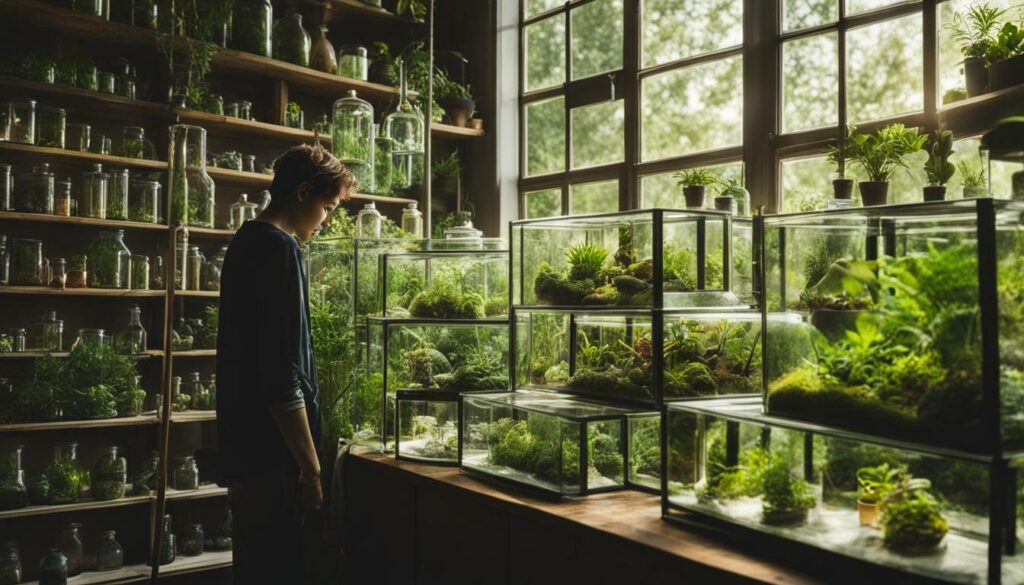
To set up your glass container terrarium, begin by layering pebbles, charcoal, and potting soil, then carefully place your chosen plants and add any desired decorative elements. The layered pebbles at the bottom of the container will provide drainage for excess water, ensuring the roots of your plants don’t become waterlogged. The horticultural charcoal placed on top of the pebbles will help prevent any sour odors that may develop over time.
Next, distribute the potting soil evenly over the charcoal layer, creating a stable foundation for your plants. Make small holes in the soil using your fingers or a small tool, and gently place the roots of your selected plants into their respective holes. Ensure that the plants have enough space to grow and aren’t overcrowded.
Once the plants are in place, it’s time to enhance the visual appeal of your terrarium. Consider adding decorative elements such as small figurines, colored stones, or moss to create a more personalized and aesthetic display. These elements can add interest and texture to your terrarium. Be creative and experiment with different arrangements to achieve the desired look.
Finally, if your glass container terrarium comes with a lid, carefully close it to create a self-contained environment. The lid will help retain moisture within the terrarium, reducing the need for frequent watering. However, if your terrarium doesn’t have a lid, place it in an area with plenty of natural light, such as a sunny windowsill or near a bright source of indirect light.
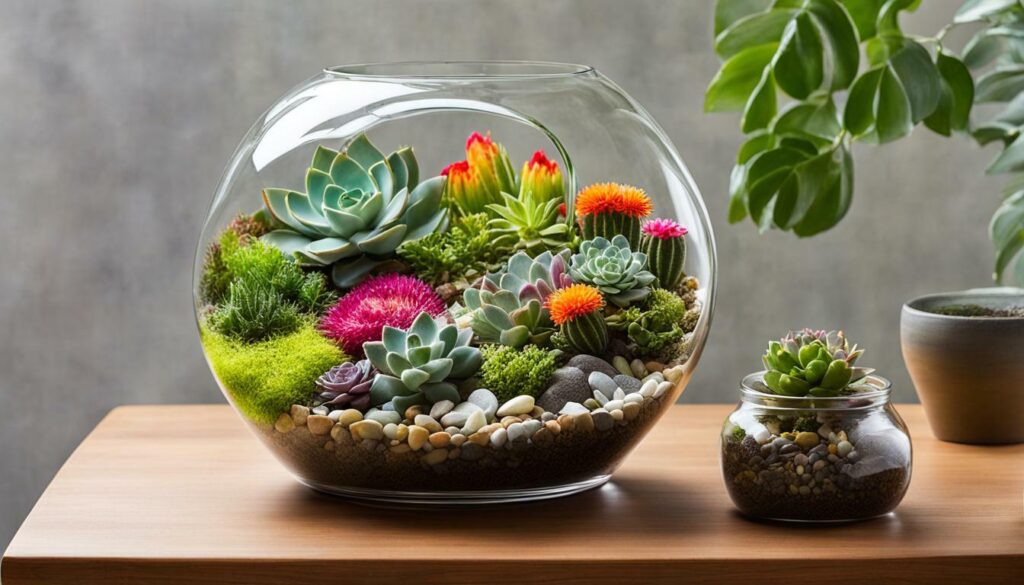
By following these steps to set up your glass container terrarium, you can create a beautiful and low-maintenance mini-garden that brings a touch of nature into your living space. Remember to regularly monitor the moisture levels and adjust watering accordingly. With proper care, your terrarium will thrive and provide you with joy and tranquility for years to come.
Maintaining and Enjoying Your Terrarium
To ensure the longevity and beauty of your terrarium, place it in an area with plenty of natural light and spray it with water every couple of weeks. Natural light is vital for the photosynthesis process, allowing the plants to thrive and grow. Find a spot near a sunny window where your terrarium can receive adequate sunlight throughout the day.
When it comes to watering your terrarium, it’s important to strike the right balance. Overwatering can lead to standing water, which can cause root rot and harm the plants. Instead, use a spray bottle to mist the leaves and soil every couple of weeks. This will provide the necessary moisture without saturating the terrarium.
In addition to light and water, it’s essential to keep an eye on the overall health of your terrarium. Inspect the leaves regularly for any signs of yellowing or wilting, as this may indicate issues such as inadequate light or overwatering. Remove any dead or decaying plant material promptly to prevent the spread of disease.
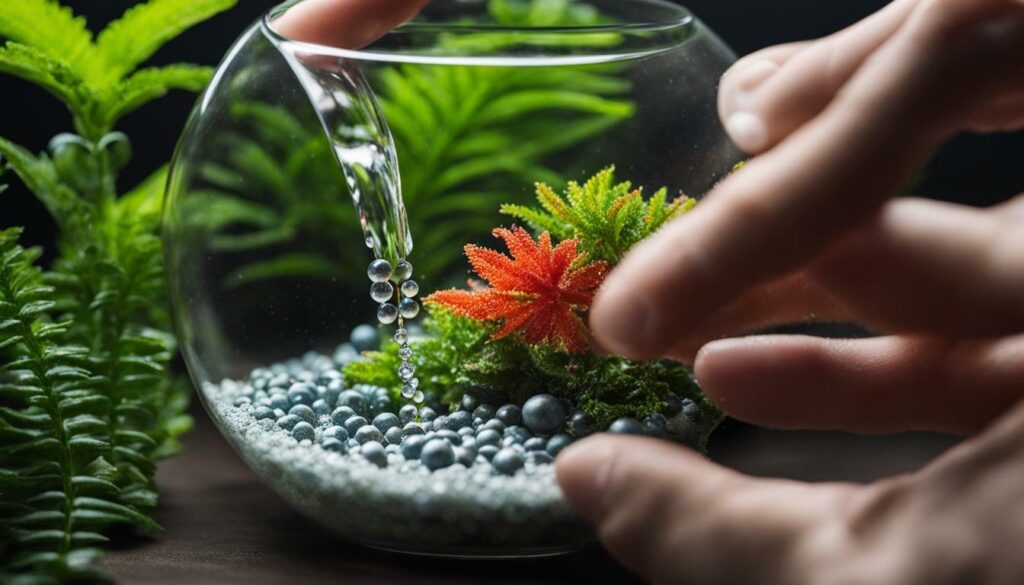
Remember that each terrarium is unique and may have slightly different care requirements depending on the plant species selected. Pay attention to any specific instructions or recommendations provided with your chosen plants.
Embrace the Natural Beauty of Glass Container Terrariums
Glass container terrariums offer a unique and captivating way to bring nature into your living spaces, adding a touch of greenery and tranquility to your surroundings. These mini ecosystems have been around for about a hundred years and have gained popularity as a low-maintenance way to enjoy indoor plants.
Whether you prefer a covered or uncovered terrarium, building your own is a rewarding and creative endeavor. To get started, you’ll need a clear glass or plastic container with a cover to create the ideal environment for your plants. Use pea gravel for drainage, horticultural charcoal to prevent any sour odors, and potting soil to provide nutrients to your plants.
When it comes to choosing the right plants for your terrarium, opt for ones that have similar light and temperature requirements. This ensures that all the plants in your terrarium will thrive together. Consider placing taller plants at the back to create depth and visual interest.
Maintaining your glass container terrarium is simple. Spray the sides of the container and the leaves of the plants to remove any dirt or dust. However, be careful not to overwater. Terrariums are a self-contained ecosystem, so watering should be done sparingly to prevent standing water and ensure the health of your plants.
Glass containers are recommended over plastic, as they are transparent and allow plants to receive the necessary light for photosynthesis. When setting up your terrarium, layer pebbles, horticultural charcoal, and potting soil. Arrange your plants and add any decorative elements for a personal touch. If your container has a lid, close it to create a humid, self-sustaining environment.
Place your glass container terrarium in an area with plenty of natural light to provide the optimal growing conditions for your plants. Additionally, spraying it with water every couple of weeks will help maintain the moisture levels within the terrarium.
Embrace the natural beauty of glass container terrariums and enjoy the calming presence of nature in your home or workspace. With a little care and attention, these miniature gardens will continue to thrive, bringing joy and tranquility to your surroundings for years to come.
Are Hanging Glass Terrariums as Low-Maintenance as Container Terrariums?
Hanging glass terrariumspushViewController enthusiasts often tout their effortless charm, yet they may require meticulous moisture management compared to container terrariums. Ensuring adequate air circulation and avoiding overwatering are key to maintaining the delicate balance within these suspended ecosystems.
FAQ
Can I use a plastic container for my terrarium?
While glass containers are generally recommended for terrariums because they allow plants to receive the necessary light for photosynthesis, you can use a plastic container if desired. However, keep in mind that plastic containers may not be as transparent and may not provide the same aesthetic appeal.
How often should I water my terrarium?
Watering should be done sparingly to prevent standing water in the terrarium. It is recommended to spray the terrarium with water every couple of weeks to provide moisture to the plants without overwatering them.
Can I use any type of plants in my terrarium?
It is important to choose plants that have similar light and temperature requirements for your terrarium. This will ensure that all the plants can thrive in the same environment and will make maintenance easier.
What can I use as decorative elements in my terrarium?
You can add various decorative elements to personalize your terrarium, such as small figurines, rocks, or moss. Just make sure that any decorative elements you add are safe for the plants and won’t interfere with their growth.
Do I need to provide artificial lighting for my terrarium?
In most cases, natural light is sufficient for the plants in a terrarium. However, if your terrarium is placed in an area with limited natural light, you may consider providing supplemental artificial lighting to ensure the plants receive the necessary light for photosynthesis.

